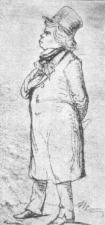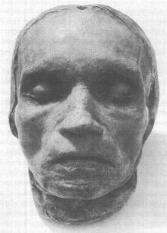Beethoven wrote fewer symphonies than Mozart, completing but nine. Each of these nine is shrouded in a deserved air of majesty. In Beethoven's symphonies we get the sense that he is grappling with some larger issue whether philosophical or personal. Thus the Sixth Symphony is often associated with Beethoven's hearing loss; the Third with Beethoven's revolutionary yearnings; the Ninth with a quest for Universal Truth.
Generally, Beethoven's career is divided into three stages: an early period when, as a youth in Bonn and Vienna, his music was strongly influenced by Mozart and Mozart's (and Beethoven's) teacher Haydn. Works from this period include his First and Second Symponies. The second period, known as the "Heroic period," provides us with many of his most popular works, such as his Third through Sixth Symphonies, his Pathetique and Appassionata piano sonatas; these works have a certain monumentality, power and drive to them. The works of his final period, known as his Late Period, tend to be more fragmented and inscrutable, with quicker changes of mood and topic. Works from his late period include the Seventh through Ninth Symphonies, the Hammerklavier sonata, the Diabelli variations, and the late string quartets.
Probably the most famous piece of Beethoven's late period is the Ninth Symphony in D minor; its triumphant final movement is known as the "Ode to Joy." This simple folk-like melody has been appropriated and used for all manner of means: from the Catholic hymn "Praise the Lord, ye Heavens" to uses both representative of freedom from tyranny: Bernstein performed it at a celebration of the fall of the Berlin Wall, to the most absolute tyranny: Furtwangler's performance during Hitler's birthday celebration in 1942. During the Cultural Revolution, the Chinese saw it as indicative of capitalist and reactionary values. The Japanese on the other hand saw it as a reflection of their spiritual life. Nineteenth-century interpretation of this symphony has ascribed many types of romantic sentiment to the work: ranging from a musical equivalent of Genesis to an autobiography of the composer. Even something as seemingly simple as the tenor's first line of text, "Brothers, no more of these tones" has proven ambiguous. What exactly does he refer to when he says "these tones"? the symphony as a whole? the schrekensfanfare, or "horror fanfare", to use Wagner's term, that had immediately preceded it? or music in general? However one looks at it, Beethoven has created a work that begs interpretation.
Contemporary reaction to the work varied. The critic of the Theater-Zeitung saw "the airy frame of instrumental music..no longer sufficient for the deeply moved artist. He needs to take the word, the human voice, to aid him so that he may express himself adequately." On the other hand, Fanny Mendelssohn, the erstwhile composer and sister of the more famous Felix, wrote that the final movement was "a gigantic tragedy with a conclusion meant to be dithyrambic, but falling from its height into the opposite extreme - into burlesque." Gottfried Fink, who heard the work in 1826 called it "a festival of hatred towards all that can be called human joy. With gigantic strength the perilous hoard emerges, tearing hearts asunder and darkening the divine spark of the gods with noise, monstrous mocking." Say what they will, it is for you to make your own opinion. Raise the volume and listen!


